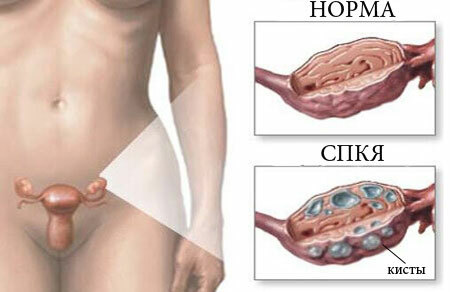The ability of a woman to conceive in many ways depends on how her ovaries function, in which each ovum cycle should mature.
Stable work of female gonads provides regular menstruation and ovulation, but some women are forced to fight with the diagnosis of PCOS, which not only becomes a serious obstacle to pregnancy, but also provokes the emergence of other endocrine pathologies.
What is it? PCOS - this disease is deciphered as a syndrome of polycystic ovaries and assumes the presence of many small follicles, which significantly increase the volume of the female reproductive gland.
Clinical picture on US

Ultrasound examines multiple follicles up to 10 mm in diameter. They are localized along the edge of the ovary and resemble a necklace in their arrangement.
When measuring the parameters of this reproductive organ, it turns out that its width is more than 30 mm, the length is more than 37 mm, and the thickness is more than 22 mm. In general, the polycystic ovary volume exceeds 10 cm3.The follicle capsule is often thickened, which prevents its rupture during the peak of LH before ovulation.
Content
- 1 Symptoms of PCOS( polycystic ovarian syndrome)
- 2 polycystic ovary Types
- 3 Influence PCOS pregnancy
- 4 Diagnosis of PCOS
- 5 Treatment of PCOS( polycystic ovarian syndrome)
- 5.1 Drug therapy PCOS
- 5.2 Surgical treatment of polycystic ovary syndrome
Symptoms of PCOS( polycysticovaries)
Signs of ovarian dysfunction and the presence of polycystosis will be visible to every woman, since this pathology can not be asymptomatic. For a more complete presentation of the clinical picture, the doctor, in addition to the results of ultrasound, will also take into account the patient's complaints.
Among the symptoms of polycystic ovary syndrome, the following can be distinguished:
Infertility - is a consequence of the absence of ovulation. They may not occur at all, or be very rare: 2-3 times a year. The inability to conceive a child can also be due to the fact that the dominant follicle in PCOS has the property either to regress or to grow into a follicular cyst.
The latter variant is much more common, because the follicle capsule is significantly thickened with this diagnosis.
Large delays in menstruation - are associated either with anovulatory cycles, or with the lengthening of the first phase of the cycle, when a large number of antral follicles are not dominant for a long time.
High level of testosterone - is formed as a result of dysfunction of the ovaries and the adrenal cortex, which begin to produce too much androgen. Exceeding the rate of these hormones slows the maturation of the egg, prevents the increase in the layer of the endometrium and causes a thickening of the capsule of the dominant follicle.
In addition, an increase in the level of androgens affects the appearance of a woman in the form of appearance of hirsutism and obesity in the male type.
Regular pain in the small pelvis - are aching and appear due to the fact that enlarged ovaries squeeze the organs of the small pelvis.
Pain sensations can be intense near the middle of the cycle, when multiple follicles in the ovaries begin to increase and exceed the volume of 10 cm3.
Painful sensations in the chest - throughout the cycle, the mammary glands are sensitive, sometimes they feel tingling, a feeling of swelling. Normally, these symptoms can be present in a woman a few days before menstruation, but with polycystic ovaries they are constant.
PCOS in gynecology is considered one of the most important causes of infertility. And if, for example, with obstruction of the fallopian tubes, IVF can help, in the case of ovarian dysfunction, even conception in a test tube often becomes impossible: either it is not possible to stimulate superovulation or improper production of hormones will kill an embryo already implanted in the uterus.
Types of polycystic ovaries
Gynecologists, based on the results of ultrasound, distinguish 2 types of polycystosis: diffuse and peripheral. They have different signs and have different effects on the patients' well-being.
- Diffuse locus of follicles( type I of polycystosis) - suggests that follicles do not have a specific location in the ovary and are scattered in the stroma.
Such patients often have normal body weight, weak manifestations of hirsutism, secondary amenorrhea and immunity to Clomifene( stimulates ovulation).In 10-12% of women with type I polycystic ovaries can regularly ovulate.
- Peripheral arrangement of follicles( II polycystosis) - is more common, in obstetric practice is considered a classic PCOS.
The follicles are located along the edge of the stroma, look like necklaces. Such patients are often obese, have a history of pregnancy, which ended in miscarriages in the early stages.
Periodically, women even experience ovulation, but almost always the luteal phase( NLF) deficiency is diagnosed.
It is possible to determine the type of polycystosis only with the help of ultrasound. The treatment regimen for PCOS should be prescribed only after studying the localization of follicles in the ovaries and the frequency of ovulation.
The effect of PCOS on pregnancy

To determine how much polycystic ovary can affect the process of bearing a child, one must keep in mind the two main effects that such a pathology produces on the reproductive area:
- Elevated androgen level;
- The presence of a thin endometrium.
Both are dangerous for the embryo. High testosterone can provoke miscarriage both in early and late pregnancy.
Therefore, women are prescribed special hormone therapy and recommend a constant monitoring of the concentration of androgen levels in the blood.
The thin endometrium may be an obstacle to the implantation of the fetal egg and the cause of its detachment in the first 3-4 weeks of pregnancy. The mucous layer of the uterus, which has a small thickness, is not always able to feed the embryo sufficiently and create a good network of blood vessels for it.
Diagnosis of PCOS
Nowadays, it is common in the world to diagnose polycystic ovary if the physician discovers two of the following three symptoms:
- Oligomenorrhoea( rare monthly) - occurs with PCOS on the background of anovulation. It is confirmed by the results of folliculometry, which is carried out for 7-8 months.
- Hyperandrogenism - occurs with PCOS due to dysfunction of the ovaries and the adrenal cortex. It is confirmed by blood tests for androgens( testosterone and dehydrotestosterone).
- Echographic features of polycystic ovaries suggest an evaluation of the results of ultrasound diagnosis. Moreover, this diagnosis should be carried out at least twice per cycle: at the beginning and at the end.
The presence of two of the three conditions gives rise to a diagnosis of PCOS, if a woman excludes any other reasons for the formation of polycystosis.
Treatment of PCOS( polycystic ovary syndrome)

Ovarian dysfunction is difficult to treat. After all, it is necessary to work on restoring the normal functioning of not only the female gonads, but the entire endocrine system.
Otherwise, PCOS treatment will only have a temporary effect. Therefore, before the gynecologist-endocrinologist, the following tasks are required, requiring a consistent solution:
- Normalization of the patient's metabolism and body weight;
- Restoration of regular menstruation against the background of ovulatory cycles;
- Restoration of the endometrial structure in the uterus;
- Control of hirsutism,
Earlier, doctors used active treatment for the treatment of polycystosis, in addition to prescribing drugs. But over time it became clear that surgery is not always possible, and gynecologists focused on improving drug therapy. Currently, both methods of conservative treatment and methods of surgery are used to combat PCOS.
Medication therapy PCOS
- 1 stage of treatment : normalization of metabolism and body weight
The better the body can absorb food, the fewer problems will be with excessive body weight - it is from her suffer many patients with PCOS.For this, the following drugs can be prescribed:
- Sibutramine - the action is aimed at enhancing the feeling of satiety, as a result of which the patient gets rid of the constant desire to consume food. The drug is contraindicated in patients with cardiovascular disease, even if they had occurred before.
- Orlistat - prevents the absorption of fats. This has a positive effect on the process of losing weight.
Normalization of body weight causes the pituitary and hypothalamus to work in a new way, to produce hormones in the required concentration, or to allow the body to be receptive to further treatment.
- 2nd stage of treatment: restoration of menstruation, cycles of ovulation
After the body has ceased to be weighed down with excessive mass, it becomes possible to adjust the functions of the endocrine glands. To restore ovulation in PCOS use drugs:
- Clomifene - the drug for a long time proves its effectiveness, and therapy with his participation is actively used by gynecologists to this day. However, one should take into account that only representatives of the classical( second) type of PCOS are receptive to it.
- Drugs HCG - are introduced if the patient has the first type of polycystic ovary syndrome, and also in situations where ultrasound ascertaining the thickened capsule of the follicle, the integrity of which can not be disturbed without special stimulation. Preparations of hCG are administered intramuscularly when the dominant follicle reaches a size of 18 mm.
- Synthetic analogues of progesterone - prescribed to maintain the second phase of the menstrual cycle.
- Puregon( analog - GonalF) - a preparation of follicle-stimulating hormone( FSH), is prescribed for patients with clomiphene-resistant. The peculiarity of these drugs is that, on the background of their administration, the least number of cases of the ovarian hyperstimulation syndrome( HHV) was noted.
- 3 stage of treatment: restoration of endometrial structure
The choice of drugs will depend on the success of the 1 stage of treatment of PCOS, which assumed a reduction in the body weight of the patient.
- Estrogengestagens are assigned to patients who are not overweight. These can be COC preparations( combined oral contraceptives): Janine, Novinet, Regulon.
- Progestogens - are given to patients whose body weight is above normal. Among them, Duphaston, Megestron, Medroxyprogesterone-LENS, Utrozestan can be distinguished. It is important that progestogen preparations are selected that do not have androgenic activity.
- 4 stage of treatment of : control of hirsutism
The last stage of treatment of PCOS is often carried out simultaneously with the restoration of the endometrial structure, it also involves the administration of COC with antiandrogenic action.
- Dexamethasone - regulates the activity of the adrenal cortex, has a strong anti-androgenic effect. Dosage should be prescribed only by a doctor. It should be borne in mind that with the sudden cancellation of high doses of dexamethasone, the production of androgens may intensify.
- Diane-35 - contraceptives. For the treatment of hirsutism 21 days are used for 1 pills a day. Has a pronounced anti-androgenic effect.
- Cortisol is a steroid hormone that regulates the work of the adrenal cortex. The hormone itself begins to actively secrete by the adrenal cortex when stressful situations appear.
Surgical treatment of polycystic ovary syndrome
It is used mainly for patients who have clomiphene resistance. In this case, it is not possible to stimulate ovulation with medications, so women undergo laparoscopy.
During the operation, wedge resection of the ovary, as well as cauterization( destruction of the ovary stroma) is performed. However, most often in the treatment of PCOS, conservative methods are used, and even surgical intervention is supplemented with the appointment of Clomifene preparations.
With a competent approach to the treatment of polycystic ovary syndrome this diagnosis is not a verdict. Appropriate therapy will, at least, have a temporary effect and for several months will help stabilize the reproductive system so that a conception takes place.


